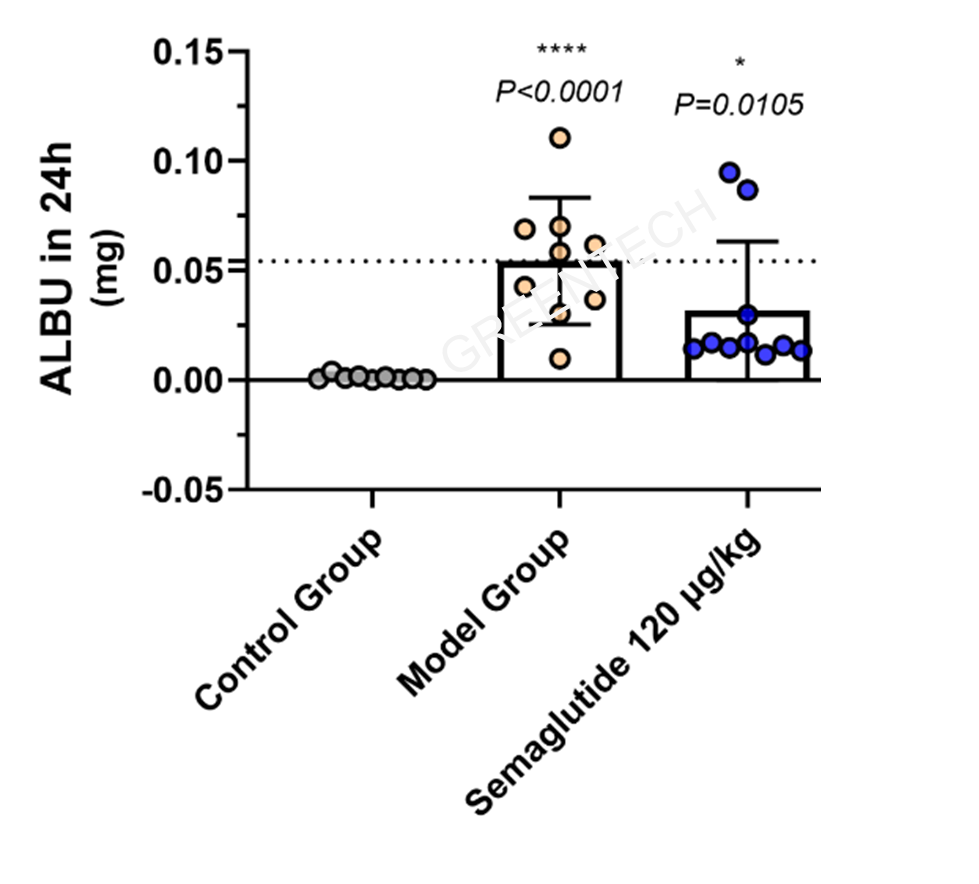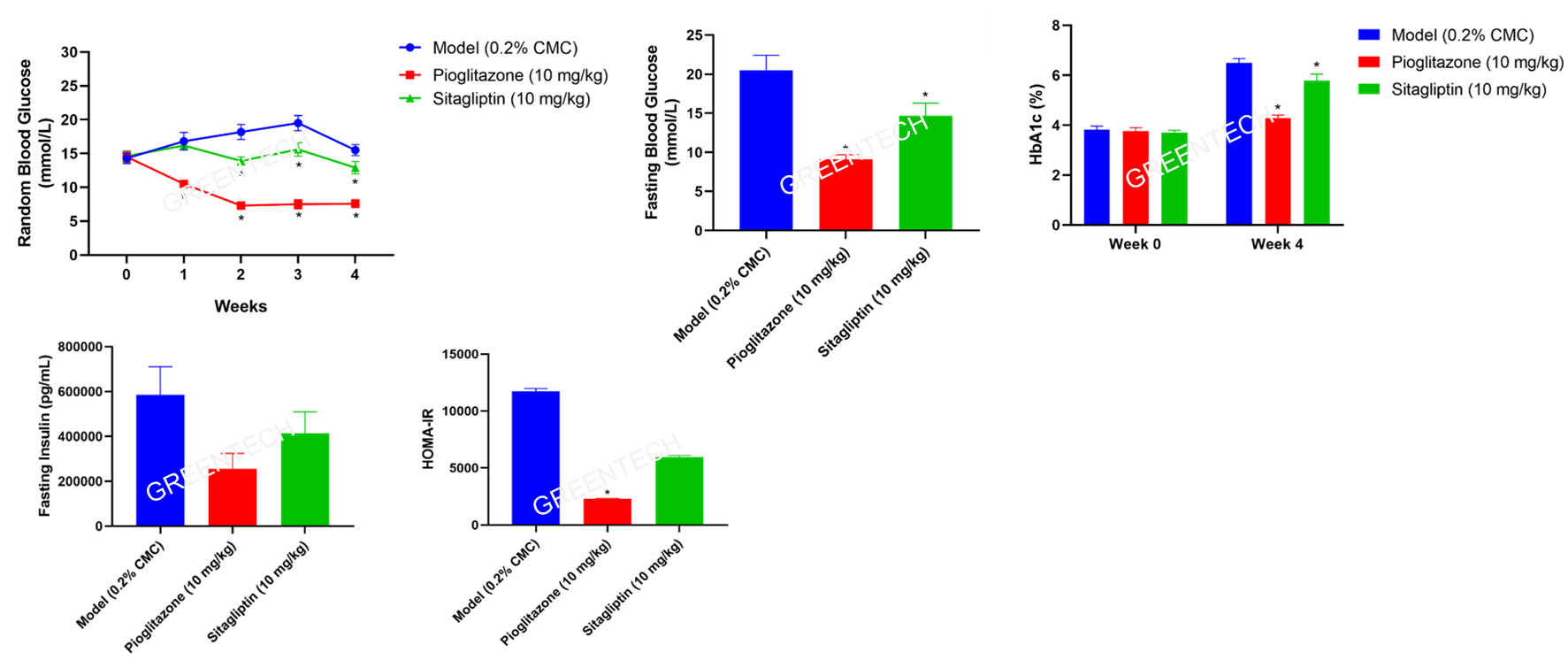Models of Diabetes and Its Complications
Greentech provides validated animal models of diabetes and associated complications, such as foot ulcer and nephropathy. Our clients can benefit from our comprehensive animal models and professional preclinical pharmacology services.
Our Animal Models of Diabetes and Diabetes-Related Complications
1. Models of type I diabetes - streptozotocin induced diabetes model
Streptozotocin (STZ) is a chemical commonly used for the generation of type 1 diabetes phenotypes in rodents. STZ induced diabetes represents a clinically relevant model of type 1 diabetes to study pathogenesis, pathophysiological changes, drug screening, and pharmacodynamics evaluation.
Animal species: mice, rats
Clinical Assessment
(1) Body weight, food intake
(2) Blood glucose, HbA1C, insulin level
(3) Blood biochemistry
(4) Oral glucose tolerance test (OGTT), intravenous glucose tolerance test (IVGTT), insulin tolerance test (ITT)
2. Spontaneous models of type II diabetes
Greentech offers a variety of spontaneous type II diabetes models, including ob/ob mice, db/db mice, and Zucker diabetic fatty (ZDF) rats. Spontaneous diabetic models are used frequently to study the mechanisms and pathophysiologic progress of T2DM and evaluate effective treatments, since many of them closely resemble the clinical features of T2DM, as well as associated complications, especially obesity and insulin resistance.
Animal species: ob/ob mice, db/db mice, ZDF rats
Clinical Assessment
(1) Body weight, food intake
(2) Blood glucose, HbA1C, insulin level
(3) Blood biochemistry
(4) Oral glucose tolerance test (OGTT), intravenous glucose tolerance test (IVGTT), insulin tolerance test (ITT)
3. Diabetic foot ulcer model - excisional wound splinted model
Greentech provides excisional wound splinted models in mice and rats. Following STZ injection induced severe diabetes, a splinting ring tightly adheres to the skin around a full-thickness excision, preventing local skin contraction and thus mimicking wound healing process through granulation in humans.
Animal species: C57BL/6 mice, db/db mice, rats
Clinical Assessment
(1) Body weight
(2) Wound measurement and healing rate
(3) Histopathology, IHC
4. Models of diabetic nephropathy
Greentech provides both models of type 1 diabetic nephropathy and type 2 diabetic nephropathy. Spontaneous type 2 diabetic mice such as db/db mice and ob/ob mice develop renal damage at 12~14 week, which are ideal type 2 diabetic nephropathy model. Type 1 diabetic nephropathy is induced in mice or rats by STZ injection, eliciting increased proteinuria and kidney pathological changes.
Animal species: dbdb/ mice, ob/ob mice, C57BL/6 mice, rats
Clinical Assessment
(1) Body weight
(2) Blood glucose
(3) Kidney function: Scr, BUN, glomerular filtration rate, 24-hour urine protein tests
(4) Histopathology: H&E, PAS, Masson staining
(5) IHC
Case Study
1. ob/ob mouse model of type 2 diabetes
Figure 1. Metabolic profile of ob/ob mice after four-week treatment of 10 mg/kg Sitagliptin or Pioglitazone from d0 to d28.
2. Diabetic foot ulcer model

Figure 2. C57BL/6 mouse excisional wound splinted model.
3. Model of diabetic nephropathy

Figure 3. 24-hour urine protein in db/db mice after 8-week treatment of Semaglutide starting from 8 weeks of age.

Figure 4. H&E and PAS staining of kidneys from db/db mice after 8-week treatment of Semaglutide starting from 8 weeks of age.
Inquiries
Request a quote now, or email us at BD@greentech-bio.com to inquire about our services or obtain a quote for your project.
References
1. Gurley SB, Clare SE, Snow KP, Hu A, Meyer TW, Coffman TM. Impact of genetic background on nephropathy in diabetic mice. Am. J. Physiol. Renal Physiol. 2006; 290: F214–22.
2. VALIDATION OF MOUSE MODELS OF DIABETIC NEPHROPATHY. Animal Models of Diabetic Complications Consortium.
3.Xusheng Wang 1, Jianfeng Ge, Edward E Tredget, Yaojiong Wu. The mouse excisional wound splinting model, including applications for stem cell transplantation. Nat Protoc.. 2013 Feb;8(2):302-9.












